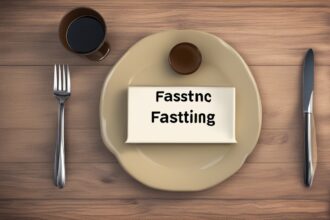Have you ever wondered what fasting is and why it’s become such a buzzword in the health and wellness world? If you’re curious about fasting explained in a way that’s easy to grasp, you’ve come to the right place. Fasting isn’t just a trend; it’s an ancient practice with roots in various cultures and religions, now backed by modern science for its potential health benefits. Whether you’re looking to improve your metabolism, lose weight, or simply reset your relationship with food, understanding fasting can open up a new path to wellness. In this comprehensive guide, we’ll break down what fasting really means, explore its different forms, dive into the science behind it, and offer practical tips to get started safely. Let’s embark on this journey to uncover the power of fasting together!
What is Fasting? The Basics of Fasting Explained
At its core, fasting is the voluntary act of abstaining from food and, in some cases, drink for a specific period. It’s not about starvation or deprivation but rather about giving your body a break from constant digestion. When we talk about fasting explained, it’s important to note that this practice has been around for centuries, often tied to spiritual or religious purposes, like Ramadan in Islam or Lent in Christianity. Today, however, many people turn to fasting for health reasons, such as boosting metabolism or improving mental clarity. Fasting can vary widely in duration and intensity, from skipping a single meal to going without food for several days under medical supervision. The key idea is to create a window of time where your body shifts focus from processing food to other vital functions like repair and renewal.
Different Types of Fasting: Finding What Works for You
Not all fasting is the same, and that’s the beauty of it—there’s a style for nearly everyone. When exploring fasting benefits and methods, you’ll come across several popular approaches. Intermittent fasting (IF), for instance, is one of the most common today, involving cycles of eating and fasting, such as the 16/8 method where you fast for 16 hours and eat during an 8-hour window. Then there’s water fasting, where you consume only water for a set period, often 24–72 hours, though this should only be done with caution. Prolonged fasting, lasting several days or more, is another option but typically requires professional guidance. There are also religious fasts, like those during Yom Kippur or Buddhist practices, which often have specific rules. Understanding these fasting types helps you choose a method that aligns with your lifestyle and health goals.
The Science Behind Fasting: Why It Works
Now that we’ve covered the basics of fasting explained, let’s dive into the science that makes it so intriguing. When you fast, your body undergoes a metabolic switch. Normally, it relies on glucose from food for energy, but during fasting, after about 12–14 hours without food, it starts tapping into stored fat for fuel through a process called ketosis. Research shows this can aid in weight loss and improve insulin sensitivity, which is crucial for managing blood sugar levels. Fasting also triggers autophagy, a cellular “clean-up” process where damaged cells are recycled, potentially reducing inflammation and supporting longevity. Studies, such as those published in the New England Journal of Medicine, suggest that intermittent fasting may lower the risk of chronic diseases like diabetes and heart disease. While more research is needed, these fasting health effects highlight why this practice is gaining traction in scientific circles.
Benefits of Fasting: More Than Just Weight Loss
One of the most exciting aspects of fasting explained is the wide range of benefits it offers beyond shedding a few pounds. While weight management is a common motivator, fasting can do so much more for your body and mind. Here are some key advantages backed by emerging science and anecdotal evidence:
- Improved Metabolic Health: Fasting can enhance insulin sensitivity and help regulate blood sugar, potentially reducing the risk of type 2 diabetes.
- Enhanced Brain Function: Some studies suggest fasting boosts the production of brain-derived neurotrophic factor (BDNF), a protein linked to better memory and learning.
- Cellular Repair: Through autophagy, fasting may help clear out damaged cells, supporting overall health and possibly slowing aging.
- Better Gut Health: Giving your digestive system a rest can promote a healthier gut microbiome, which is essential for immunity and mood regulation.
These fasting advantages show that it’s not just a diet hack—it’s a holistic approach to wellness when done correctly.
Practical Tips for Starting Your Fasting Journey
If you’re new to fasting, jumping in headfirst can feel daunting. That’s why, as part of fasting explained, we’re sharing actionable tips to ease you into this practice safely and sustainably. Fasting doesn’t have to be complicated, but it does require some preparation and mindfulness. Here are a few beginner-friendly strategies to consider:
- Start Small: Begin with a simple 12-hour overnight fast (e.g., stop eating at 8 PM and eat again at 8 AM) before trying longer windows like 16/8 intermittent fasting.
- Stay Hydrated: Drink plenty of water during fasting periods to avoid dehydration, especially if you’re cutting out calories completely.
- Listen to Your Body: If you feel dizzy, overly fatigued, or unwell, break your fast with a light meal and reassess your approach.
- Choose Nutrient-Dense Foods: When breaking your fast, opt for whole foods like vegetables, lean proteins, and healthy fats to nourish your body.
- Consult a Professional: If you have medical conditions or are on medication, speak with a doctor or dietitian before starting any fasting routine.
By following these tips, you can build a fasting practice that feels manageable and supports your long-term health goals.
Common Myths and Misconceptions About Fasting
As we wrap up our deep dive into fasting explained, let’s address some myths that might be holding you back. One common misconception is that fasting means starving yourself, which isn’t true—it’s a controlled, intentional break from eating, not a punishment. Another myth is that fasting slows your metabolism; in reality, short-term fasting can actually boost metabolic rate by increasing norepinephrine levels, according to some studies. People also worry that fasting leads to muscle loss, but when done properly with adequate protein intake during eating windows, this risk is minimal. Lastly, many assume fasting is only for weight loss, but as we’ve discussed, its benefits extend to mental clarity, cellular health, and more. Clearing up these misunderstandings helps you approach fasting with confidence and realistic expectations.
In conclusion, understanding fasting explained reveals a powerful tool for enhancing health and well-being when approached thoughtfully. From its historical roots to the cutting-edge science supporting benefits like improved metabolism and cellular repair, fasting offers something for almost everyone—whether you’re a beginner trying intermittent fasting or exploring deeper methods. Remember, the key to success lies in starting slow, staying informed, and listening to your body’s signals. As with any health practice, individual needs vary, so consider consulting a healthcare provider to tailor fasting to your unique situation. Ready to give it a try? Take that first step with an open mind, and you might just discover a transformative way to reconnect with your body. Share your thoughts or experiences with fasting in the comments—we’d love to hear how this ancient practice fits into your modern life!






